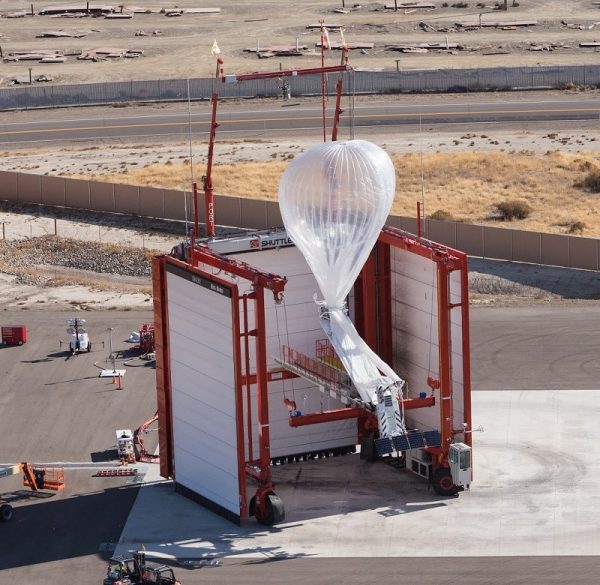Google Scraps Project Loon – 4G Rural Broadband via Balloon

Maybe it was just a lot of hot air but Google (Alphabet) has announced that Loon, their long-running project that aimed to deploy mobile broadband (4G / 5G) connectivity from High Altitude Platforms (stratospheric balloons), is “winding down” as a company after they struggled to turn it into a commercial success.
The super-pressure, helium-filled and solar powered balloons were designed to drift (controlled) at 20km (12 miles) above Earth’s surface in the stratosphere. From there they could act a bit like a budget Satellite, albeit with significantly less coverage and so several balloons would be required to cover a wide area (e.g. during 2017 one test used 7 balloons to cover an area of 1,000km).
The balloons had been designed to stay aloft for months at a time (one test remained in the sky for 223 days) and it’s possible to relay data, point-to-point, between two balloons at distances of up to 600km. As part of this they use directional patch antennas to transmit their signals to ground stations and 4G (LTE) users. In theory, consumers would thus need nothing more than a standard 4G phone to connect to the internet via the balloons.
Advertisement
Most recently a number of trials had been conducted to try and prove that the system could work reliably on a commercial basis, which if successful might have produced a cost-effective solution for connecting some of the hardest to reach parts of the planet. But sadly, the company’s CEO, Alastair Westgarth, has now confirmed that they were unable to find a way to “get the costs low enough to build a long-term, sustainable business.”
Alastair Westgarth, CEO of Loon, said:
“We talk a lot about connecting the next billion users, but the reality is Loon has been chasing the hardest problem of all in connectivity — the last billion users: The communities in areas too difficult or remote to reach, or the areas where delivering service with existing technologies is just too expensive for everyday people. While we’ve found a number of willing partners along the way, we haven’t found a way to get the costs low enough to build a long-term, sustainable business. Developing radical new technology is inherently risky, but that doesn’t make breaking this news any easier. Today, I’m sad to share that Loon will be winding down.”
Alastair now hopes that some of Loon’s technology will live on to support the next generation of innovators, such as via their recently-announced deep reinforcement learning (AI) navigation system, which is said to have “experts thinking about applications that include monitoring Earth’s vital signs and even exploration of other planets.”
Lest we forget that the approach was also facing competition from a new generation of compact Low Earth Orbit (LEO) Satellites in mega constellations.
[Insert various puns involving different plays on ‘loony’, ‘head in the clouds’,’pie in the sky’ etc.]
Advertisement
Mark is a professional technology writer, IT consultant and computer engineer from Dorset (England), he also founded ISPreview in 1999 and enjoys analysing the latest telecoms and broadband developments. Find me on X (Twitter), Mastodon, Facebook, BlueSky, Threads.net and Linkedin.
« Rural Full Fibre Broadband Pilots Start Rollout in Pembrokeshire UPDATE
Cityfibre’s UK FTTP Broadband Rollout Tops 500,000 Premises »























































No match for Starlink..
A very poor comparison. Loon was flying cell towers so it allowed people to use standard mobile phones and plans in areas where a disaster took out ground-based mobile network infrastrutre or in areas were the population can’t afford expensive satellite broadband equipment and plans.
well who didn’t see that one coming. like facebook’s floating drone platforms..
“7 balloons to cover an area of 1,000km” – do you mean 1000km^2? That’s the same as a circle of radius 18km, which doesn’t sound like very much.
The balloons may be solar powered, but ground-based stations can be solar and wind powered too.
Several are visible on Flightradar24, mostly over Kenya. They move around quite a lot, which must make it difficult to maintain reliable coverage.
Stratospheric telecommunications is an interested concept, however Loon balloons / stratolites which lack any ability to station-keep always seemed to be a ‘blue skies research’ project, rather than a pathway to commercial services.
I recall proposals for very high altitude, ultra long endurance, fixed wing, solar powered drones and helium filled airship drones, which could have been developed into commercial telecoms services.
However with the development of the SpaceX’s Starlink and (soon) Amazon’s Kuiper self-funded and self launched, low Earth orbit broadband satellite constellations, other orbital and very high altitude broadband services are at an enormous competitive disadvantage, and IMO are highly unlikely to be developed, and those in the process of deployment, are very unlikely to ever be commercially viable.
See https://www.flightradar24.com/HBAL293/26a4c651
Well no one saw that one coming lol. Its off to the dead like everything else Google has killed off…
They are on a roll for killing projects. I won’t use any new google products and they have driven me away from all but gmail now (i’ve pre-emptively moved from photos due to upcoming changes).
You have to wonder what on earth is going on with them. Who sets a $1billion target for these pie in the sky ventures?! I remember when google used to be cool and an innovator. They actually wanted people in their ecosystem, now they dont seem bothered.
@Ian your right. I’m currently in the process of moving all my photos off Google photos too. I’m still using android as I cannot stand Apple and it’s sheep. I do like the pixel phones though and the aren’t going to kill them off any time soon I don’t think as it is a large source of revenue for them no doubt. Shame though that they had to kill hangouts in replacement of “Google Chat” (RCS basically) which EE & O2 don’t even Support (yet) (I don’t think).